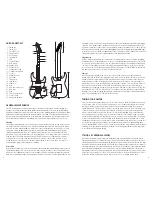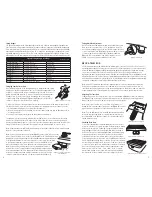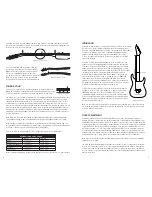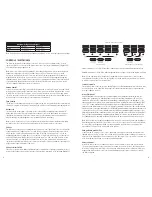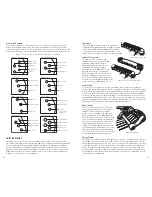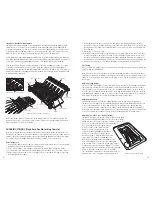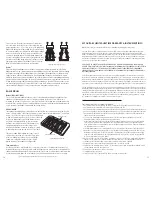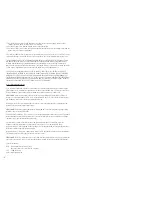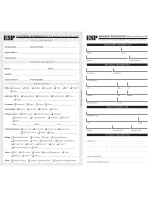
6
7
away from the frets in that area making it harder to play. Having too little bow or backbow to the neck
will cause excessive buzzing on open notes and fretted notes near the nut area, and will bring the action
down too low across the entire fretboard.
Once you have determined the amount of bow that
is in the neck, then adjust the truss rod accordingly
(Figute 8)
. Loosen the truss rod (counter-clockwise)
if your neck is backbowed. Tighten the truss rod
(clockwise) if your neck is underbowed (too much bow).
Note:
Loosen no more than 1/4 turn, then tune and
recheck neck bow until your neck is properly adjusted.
STRING ACTION
String action (or height) refers to the distance between the strings and the frets
(Figure 9)
. This distance is measured at the 12th fret and is measured from the top
of the fret to the bottom of the string on both the high and low outside strings.
The string action is set on every instrument before it is shipped to authorized ESP dealers. However, there
are many factors that can affect the string height and cause it to change. The main factor is usually a
change in temperature and/or humidity. Since our instruments ship through different climates to their
final destination, your guitar may need to be readjusted in order to bring it back to ESP factory specs.
Other factors that affect string action include changing string gauge and/or tuning. High string action will
make your guitar difficult to play, while low string action will cause excessive buzzing and unclear notes.
If your guitar needs string action adjustment, find your particular bridge system and locate the height
adjustment screws to properly adjust your guitar. You will need an accurate 6-inch steel rule to properly
measure this distance.
Note:
Make sure you have properly tuned your guitar and adjusted the truss rod before adjusting the
string height, as having to redo these adjustments will significantly change the height of the strings.
Note:
Setting your string action lower than factory settings may result in buzzing or rattling, and is not
recommended. If you are experiencing excessive buzzing or rattling, please consult with a qualified repair
technician, or double-check your neck adjustment and string heights.
Refer to the following recommended ESP factory string height settings for your guitar or bass.
Minimum String Action Heights
Bass Side
Treble Side
Guitars
2.0 mm (5/64”)
1.5 mm (1/16”)
Baritones / 7-str
2.5 mm (3/32”)
1.5 mm (1/16”)
8 String Guitar / Baritone
2.8 mm (7/64”)
1.5 mm (1/16”)
Acoustics
3.2 mm (1/8”)
2.0 mm (5/64”)
4-str basses
2.8 mm (7/64”)
2.0 mm (5/64”)
5/6/8-str basses
3.2 mm (1/8”)
2.0 mm (5/64”)
Note:
Changing string gauges may require setup adjustments for truss rod, tremolo, action, and intonation.
INTONATION
Intonation on a guitar refers to how well the guitar plays in tune with itself when
the same note or chord is played on a different area of the fretboard. Proper
intonation is achieved by adjusting the length of each string at the string saddle
(located on the bridge) to compensate for different string gauges, tunings,
heights, and string material. By moving each string saddle to the correct
location, your guitar will sound more in tune when you play across different
areas of the fretboard.
Intonation is set by comparing the fretted note at the 12th fret to the open
harmonic at the 12th fret and adjusting the string saddle to make these two
notes equal. (To get the 12th fret harmonic, lightly place one of your fretting
hand fingers directly over the 12th fret, resting your finger against the string
and pick that string normally with your picking hand.) The 12th fret is the exact
center point of the guitar’s scale length (distance measured from nut to
intonation point at bridge) and by adjusting the saddle for each string you
are essentially fine-tuning that string to its optimum position
(Figure 10)
.
Find out what type of bridge is on your guitar and locate the intonation
adjustment screws to adjust the saddle location. Make sure you have tuned
your guitar and adjusted the truss rod and string action before you start with
intonation, as it should be the last step in the setup process.
Using an electronic tuner, play the 12th fret harmonic note. Now, play the
fretted note at the 12th fret. If the fretted note is sharp, move the string
saddle back (away from the neck). If the fretted note is flat, move the
string saddle forward (towards the neck). On some guitars you may need to
loosen the string first before moving the saddle. After you have adjusted the
saddle, retune the string and repeat this process until you are able to match
the fretted note with the harmonic.
Note:
Use even pressure when fretting the notes during intonation adjustments so that all your strings
are intonated according to the same level of pressure during fretting. This will result in a more accurate
intonation when you are finished.
PICKUP ADJUSTMENT
All magnetic pickups used in ESP guitars are adjustable. Raising or lowering a pickup will increase or
decrease the amount of output from your guitar for that pickup. Pickup heights should be adjusted so that
both pickups are at about the same volume level compared to each other (this is how we adjust the pickups
from the factory). However, you may want to change the height of the pickups in order to achieve a different
output level for each pickup. Since the pickups are magnetic it is important not to adjust them too close to
the strings. If a pickup is too close to the strings, it will affect the vibration of the strings and could result
in oscillating or wavering notes, extra fret buzzing, and distortion. If you notice these problems, lower the
pickup until the notes ring true. Use a small screwdriver to adjust the pickup height (there will usually be 2
height adjustment screws for each pickup - one on the bass side and the other on the treble side).
Note:
Some instruments have pickups with adjustable pole pieces that allow you to adjust the individual
output levels of each string.
The following are maximum bridge pickup heights as set at the ESP factory. Pickup height is measured
from the top of the pickup to the bottom of the string while holding down the strings to the fretboard
at the last fret. Keep in mind that pickup heights are not meant to be at an exact level or specification
for correct operation of your instrument. Each player can set their own pickup heights according to their
desired output levels.
Figure 7:
Checking Neck Bow
Figure 9:
String Action
Figure 10:
Intonation
12th Fret
Intonation Point
Scale Lengt
h
Figure 8:
Neck Bow or Relief
Underbow
Backbow
Содержание AC10E
Страница 1: ...O W N E R S M A N U A L W A R R A N T Y I N F O R M A T I O N V E R S I O N 1 3...
Страница 11: ......



